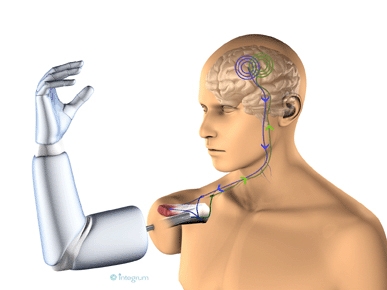‘Our technology helps amputees to control an artificial limb, in much the same way as their own biological hand or arm, via the person’s own nerves and remaining muscles. This is a huge benefit for both the individual and to society,’ said Max Ortiz Catalan, industrial doctoral student at Chalmers University of Technology in Sweden.
According to a statement, amputees have been able to use prostheses controlled by electrical impulses in the muscles but the technology for controlling these prostheses has not evolved to any great extent since they appeared in the 1960s.
‘All movements must be pre-programmed’, said Catalan. ‘It’s like having a Ferrari without a steering wheel. Therefore, we have developed a new bidirectional interface with the human body, together with a natural and intuitive control system.’
Today’s standard socket prostheses, which are attached to the body using a socket tightly fitted on the amputated stump, are said to be so uncomfortable and limiting that only 50 per cent of arm amputees are willing to use one.
This research project is using the Brånemark titanium implant, the OPRA Implant System, which anchors the prosthesis directly to the skeleton through osseointegration.
‘Osseointegration is vital to our success. We are now using the technology to gain permanent access to the electrodes that we will attach directly to nerves and muscles’, said Catalan.
Currently, in order to pick up the electrical signals to control the prosthesis, electrodes are placed over the skin but this can be problematic as signals change when the skin moves, since the electrodes are moved to a different position. Additionally, the signals are also affected when a person perspires.
In this project, the researchers are planning to implant the electrodes directly on the nerves and remaining muscles. Since the electrodes are closer to the source and the body acts as protection, the bio-electric signals become much more stable.
Osseointegration is used to enable the signals inside the body to reach the prosthesis. The electrical impulses from the nerves in the arm stump are captured by a neural interface, which sends them to the prostheses through the titanium implant. These are then decoded by algorithms that allow the patient to control the prosthesis using his or her own thoughts.
In existing prostheses, amputees use only visual or auditory feedback but with the new method, patients will receive feedback as the electrodes stimulate the neural pathways to the patient’s brain, in the same way as the physiological system. This means that the patient can control his or her prosthesis in a more natural and intuitive way, which has not been possible previously.
‘Many of the patients that we work with have been amputees for more than 10 years and have almost never thought about moving their missing hand during this time’, said Catalan. ‘When they arrived here, they got to test our virtual-reality environment or our more advanced prostheses in order to evaluate the decoding algorithms. We placed electrodes on their amputation stumps and after a few minutes, they were able to control the artificial limbs in ways that they didn’t know they could, most of the times. This made the patients very excited and enthusiastic.’
The first operations on patients will take place this winter.






Glasgow trial explores AR cues for autonomous road safety
They've ploughed into a few vulnerable road users in the past. Making that less likely will make it spectacularly easy to stop the traffic for...